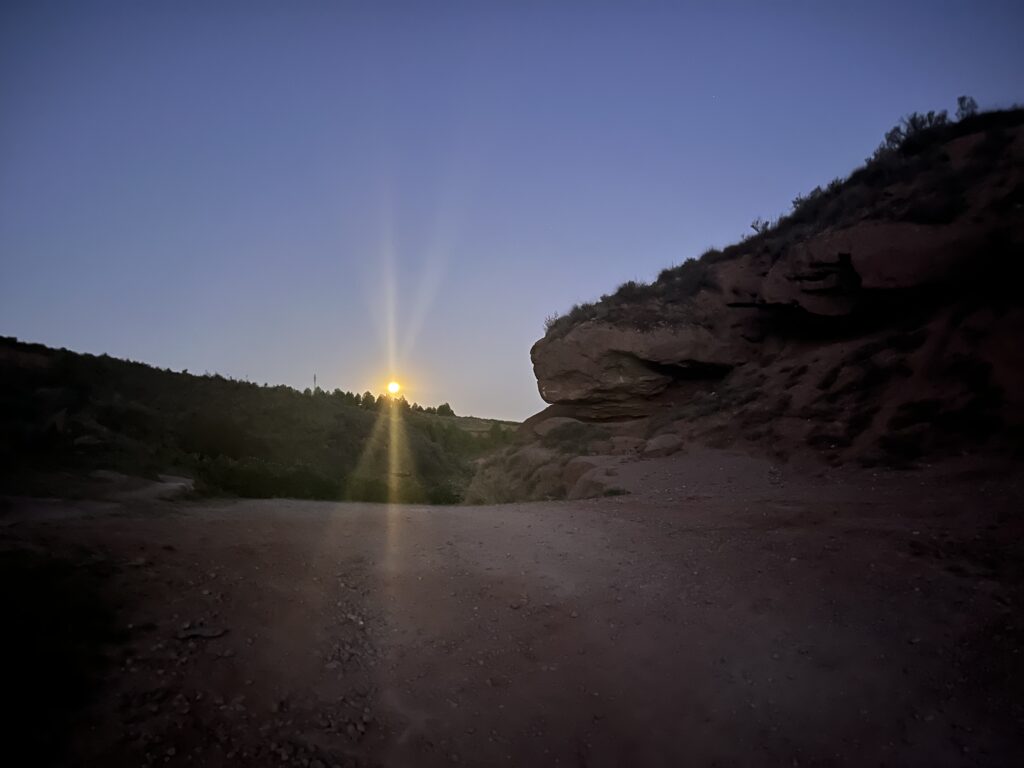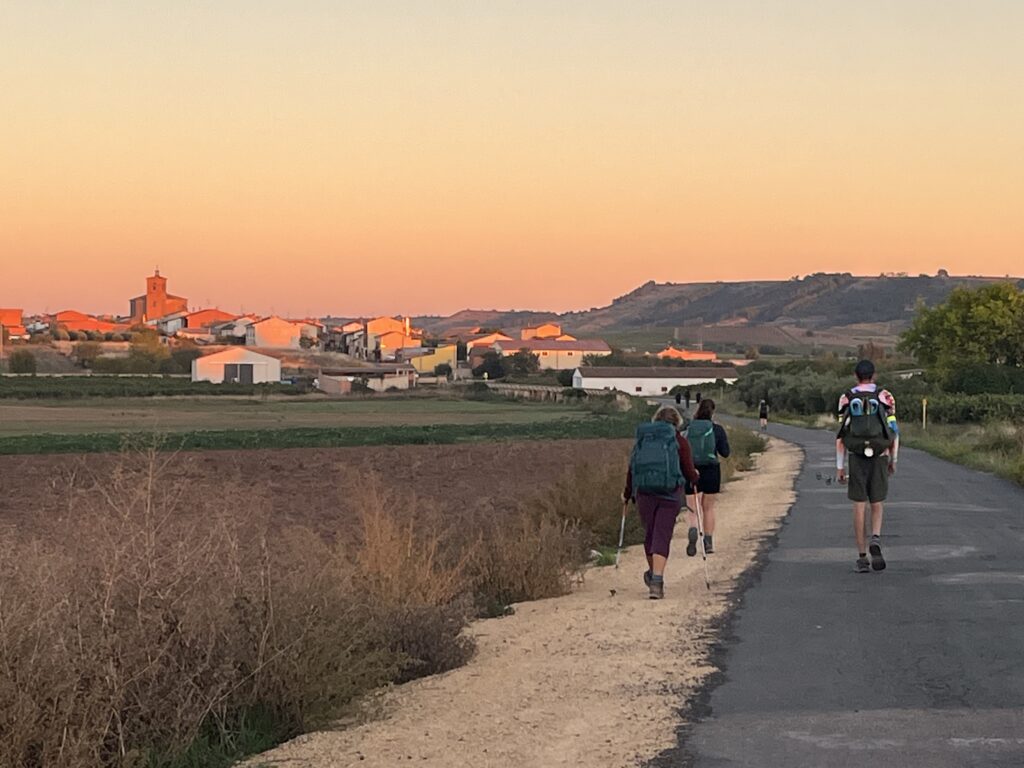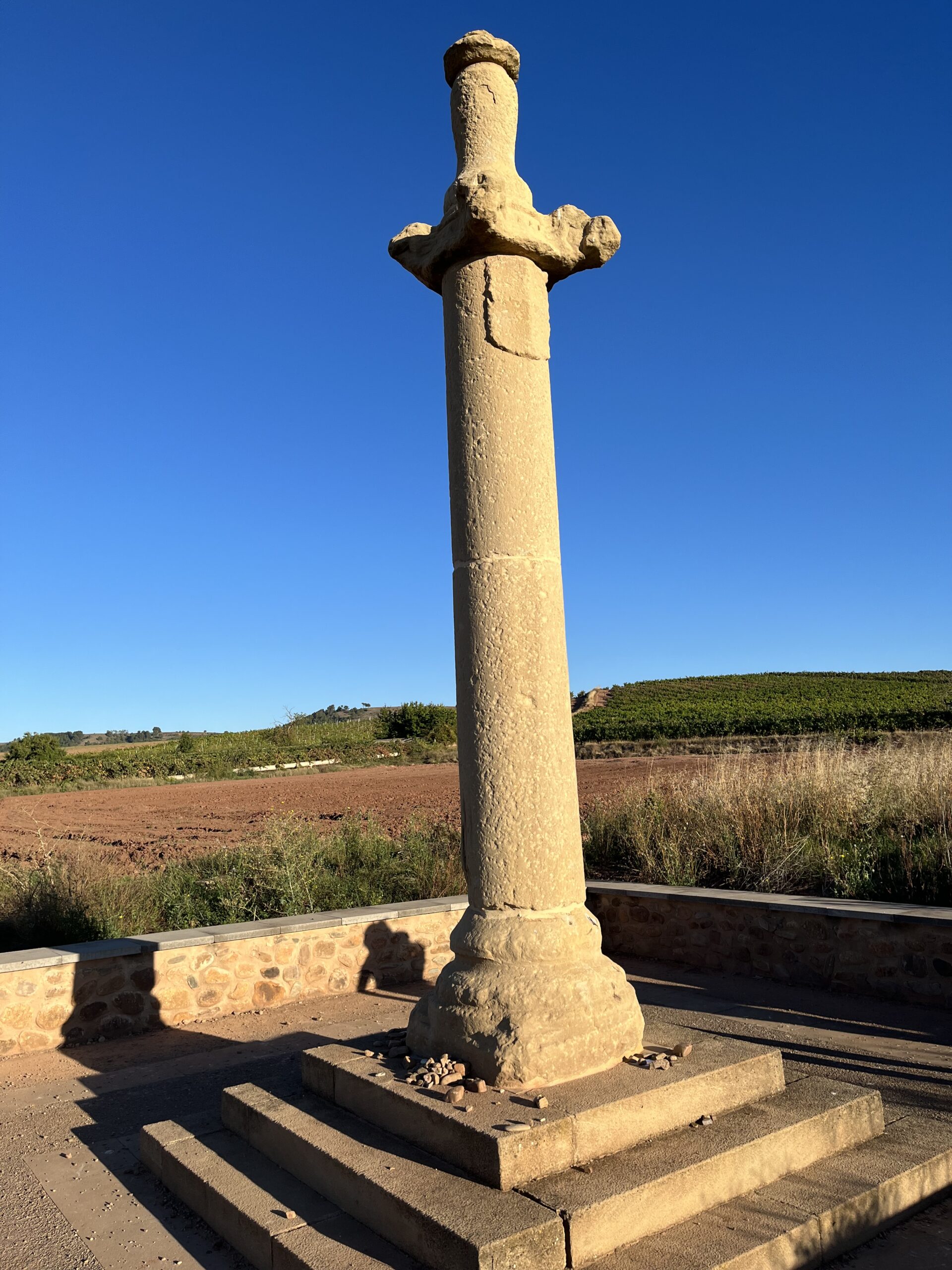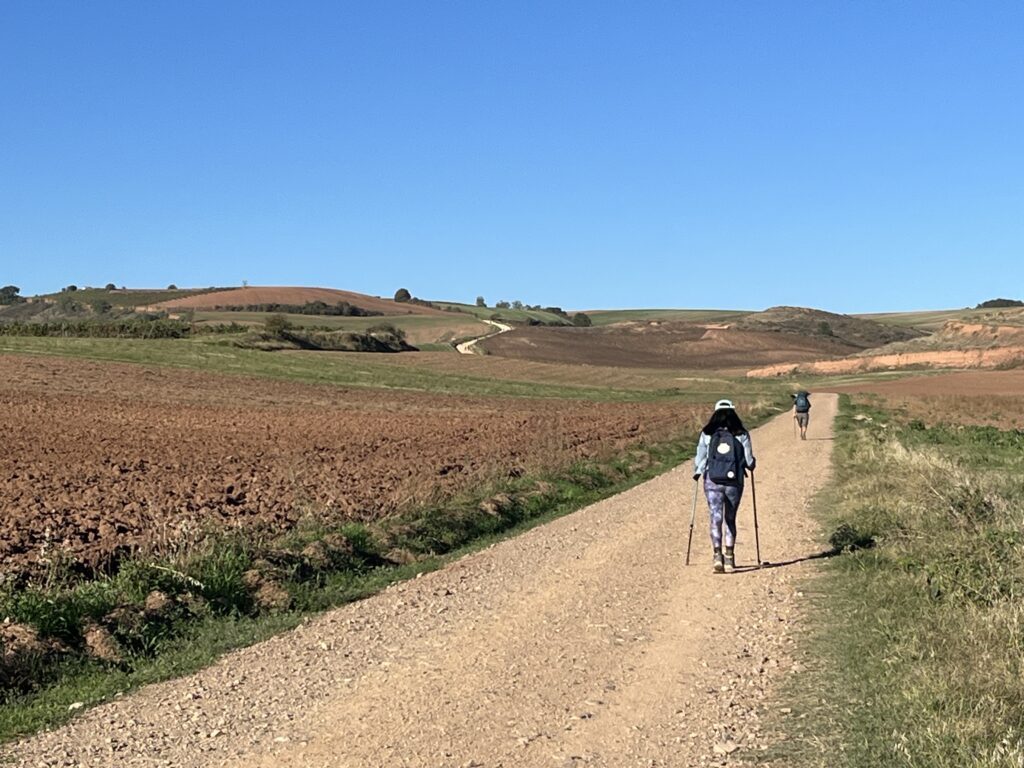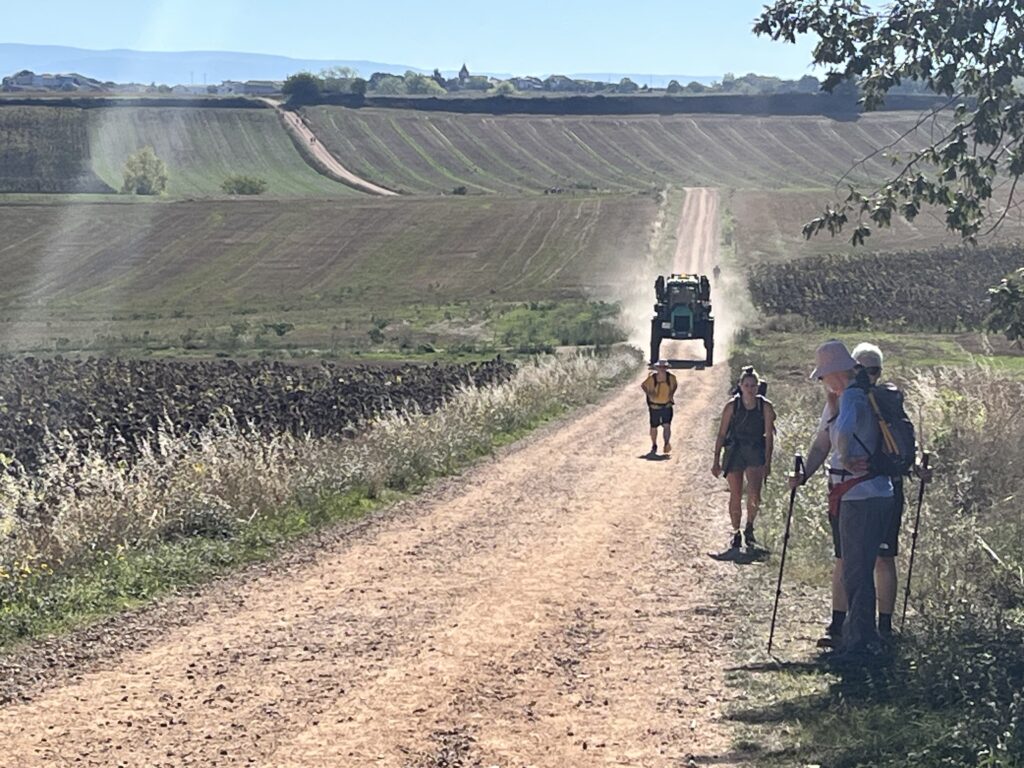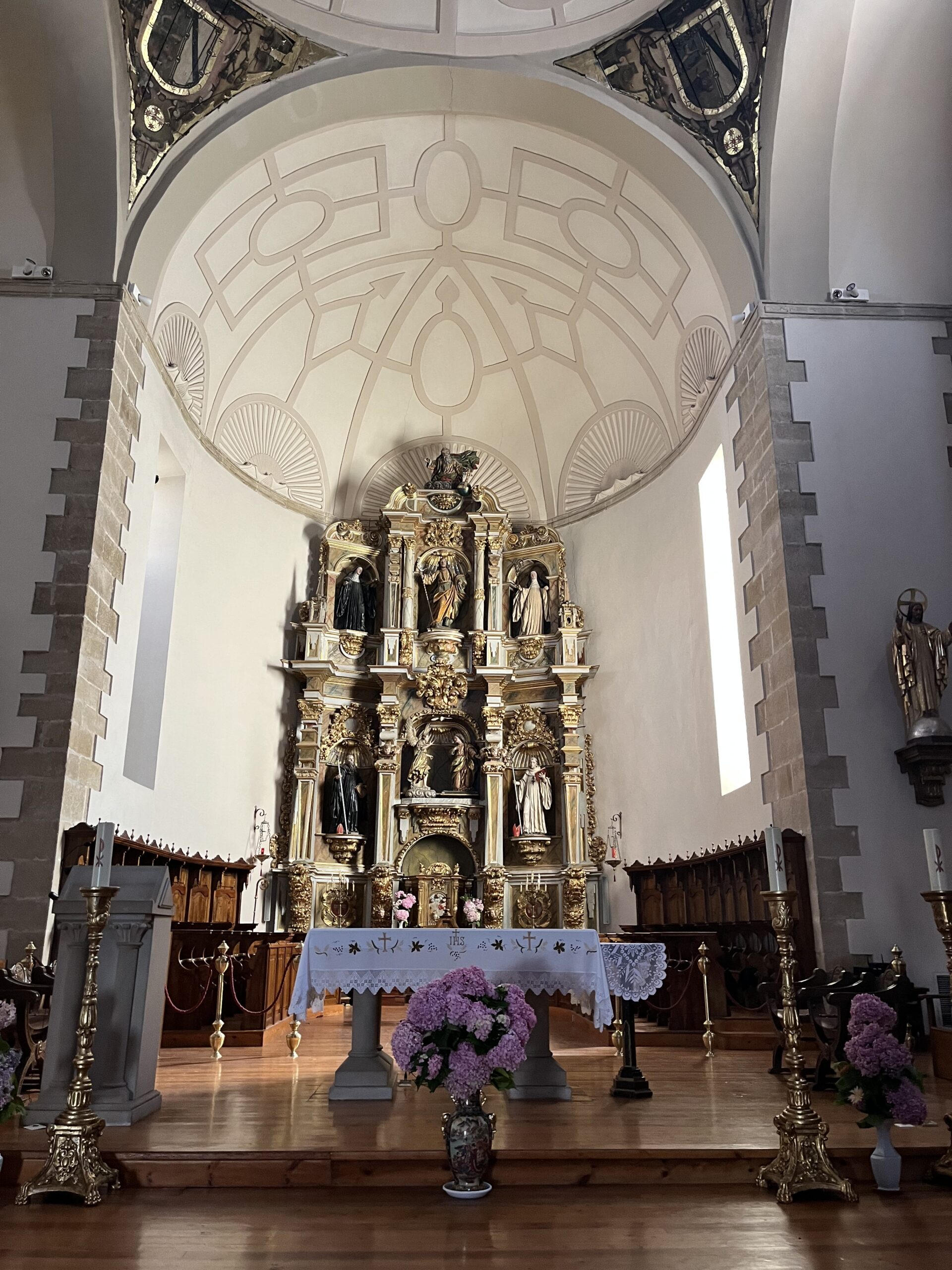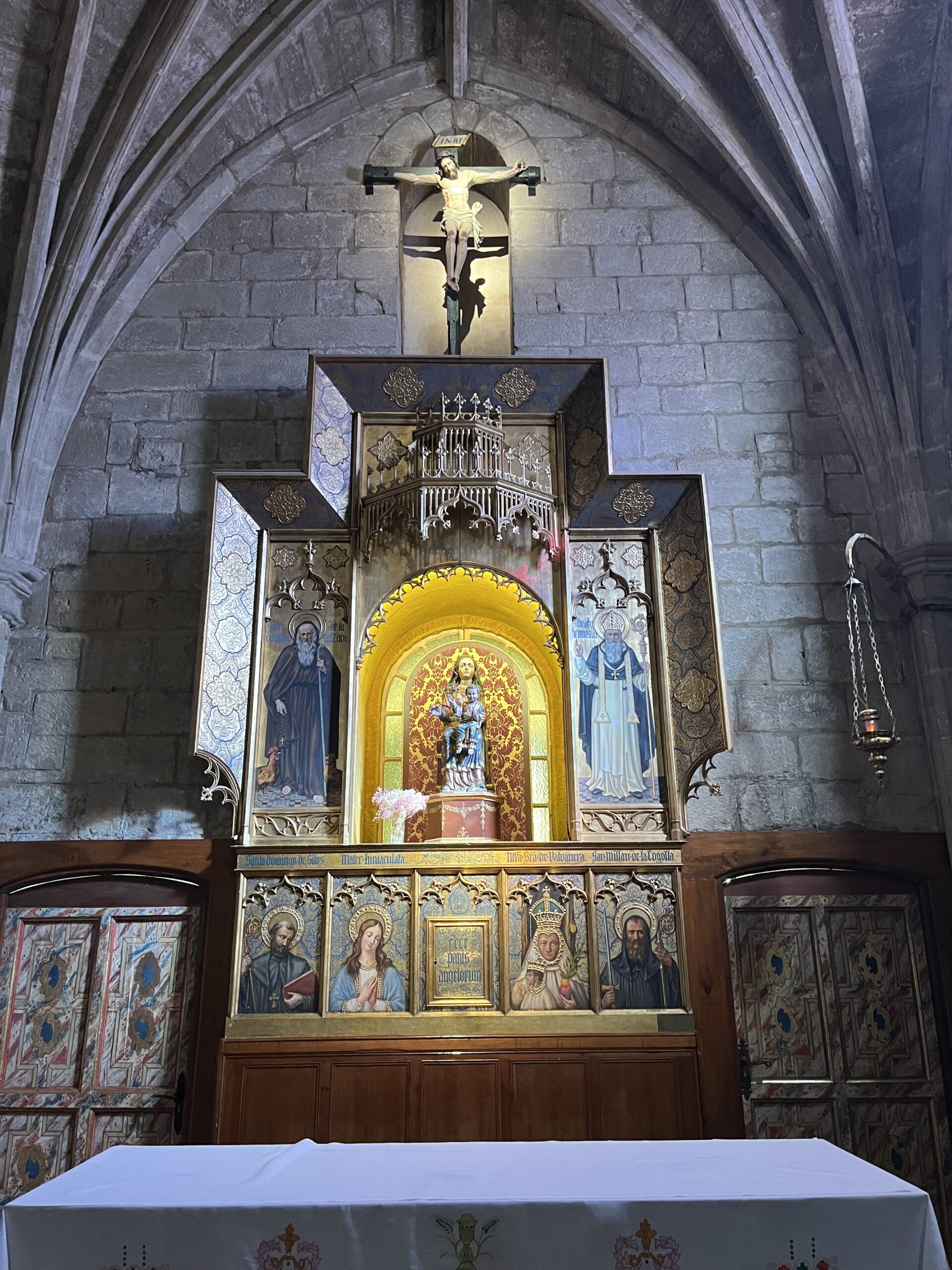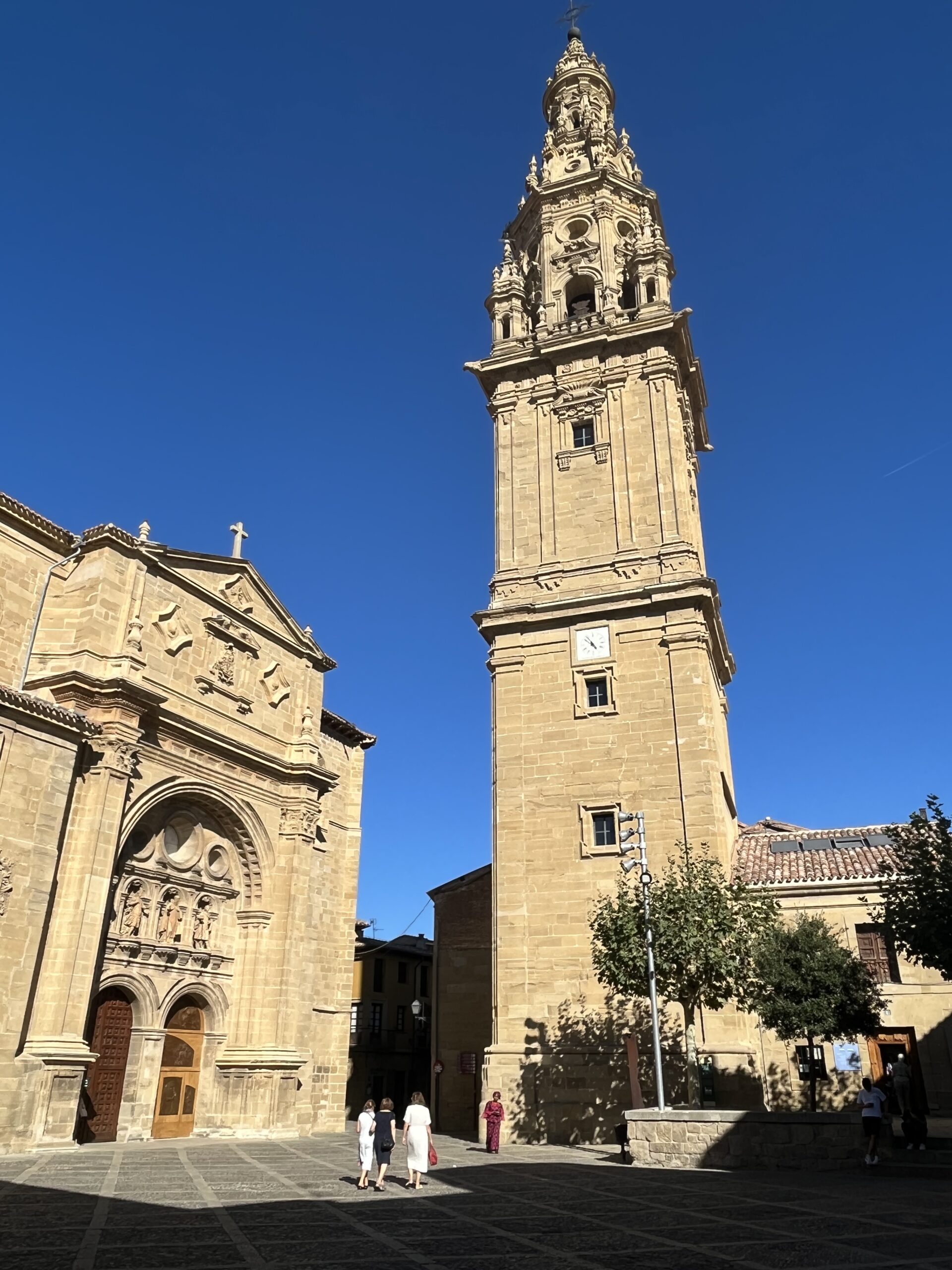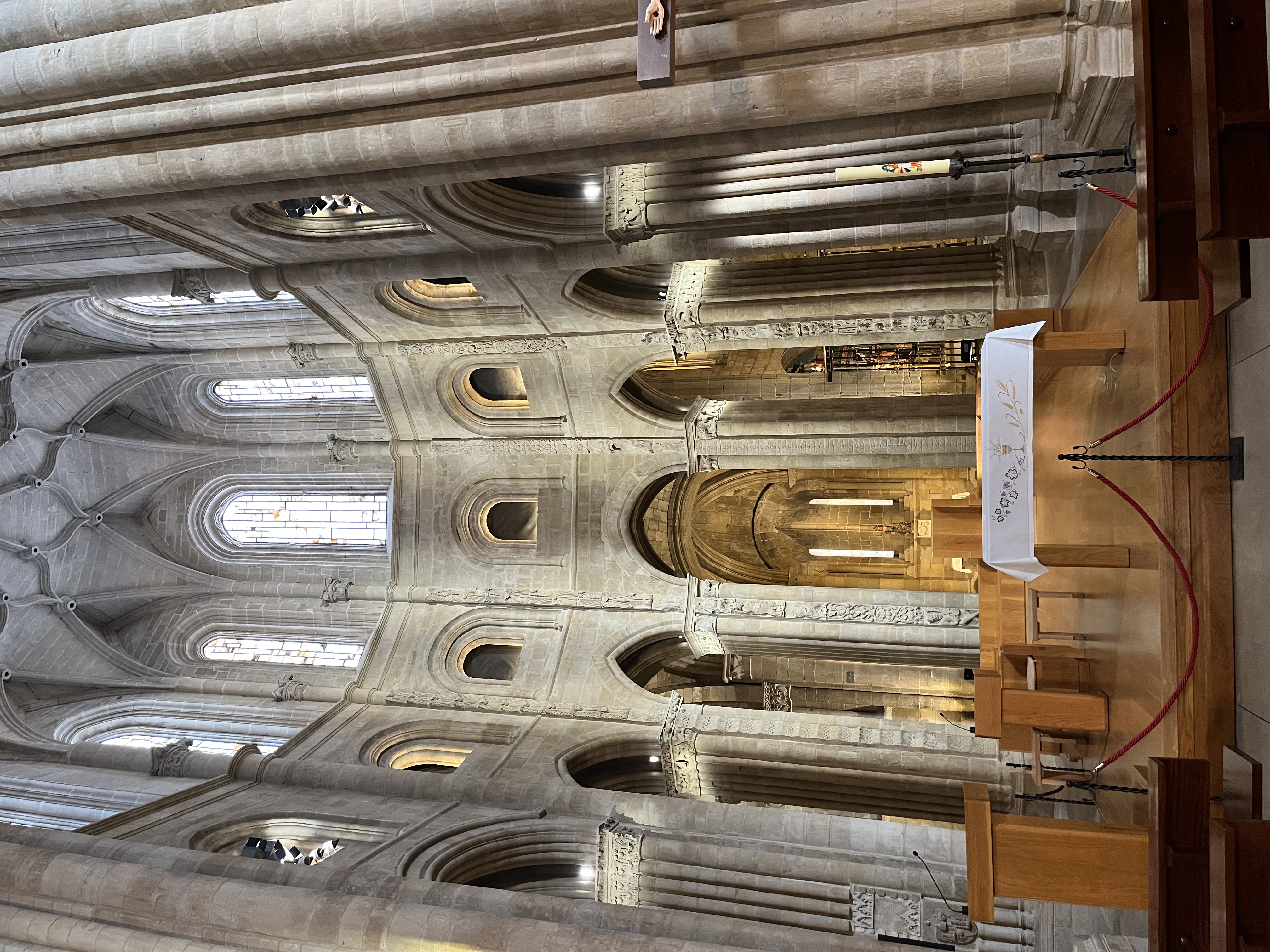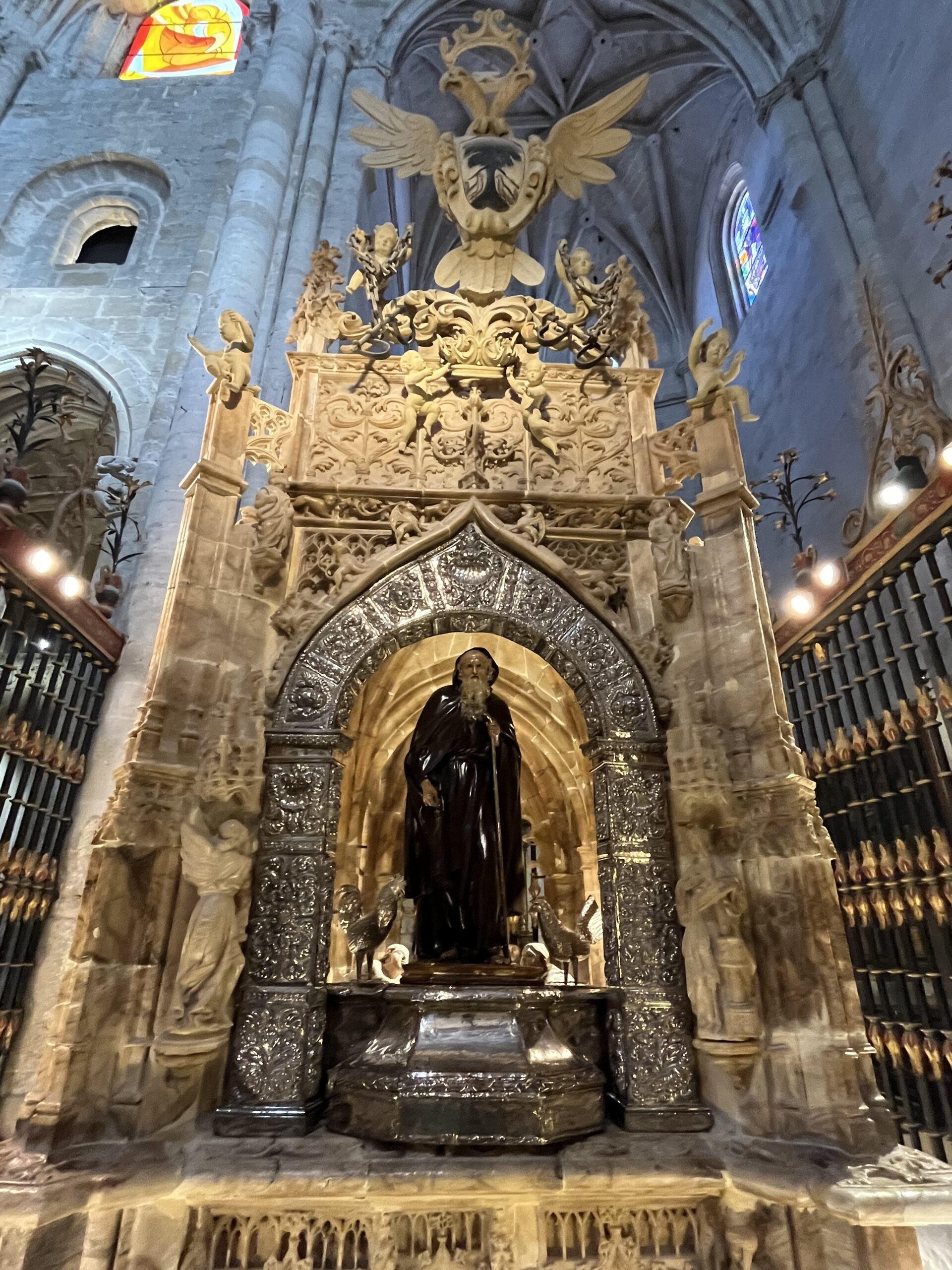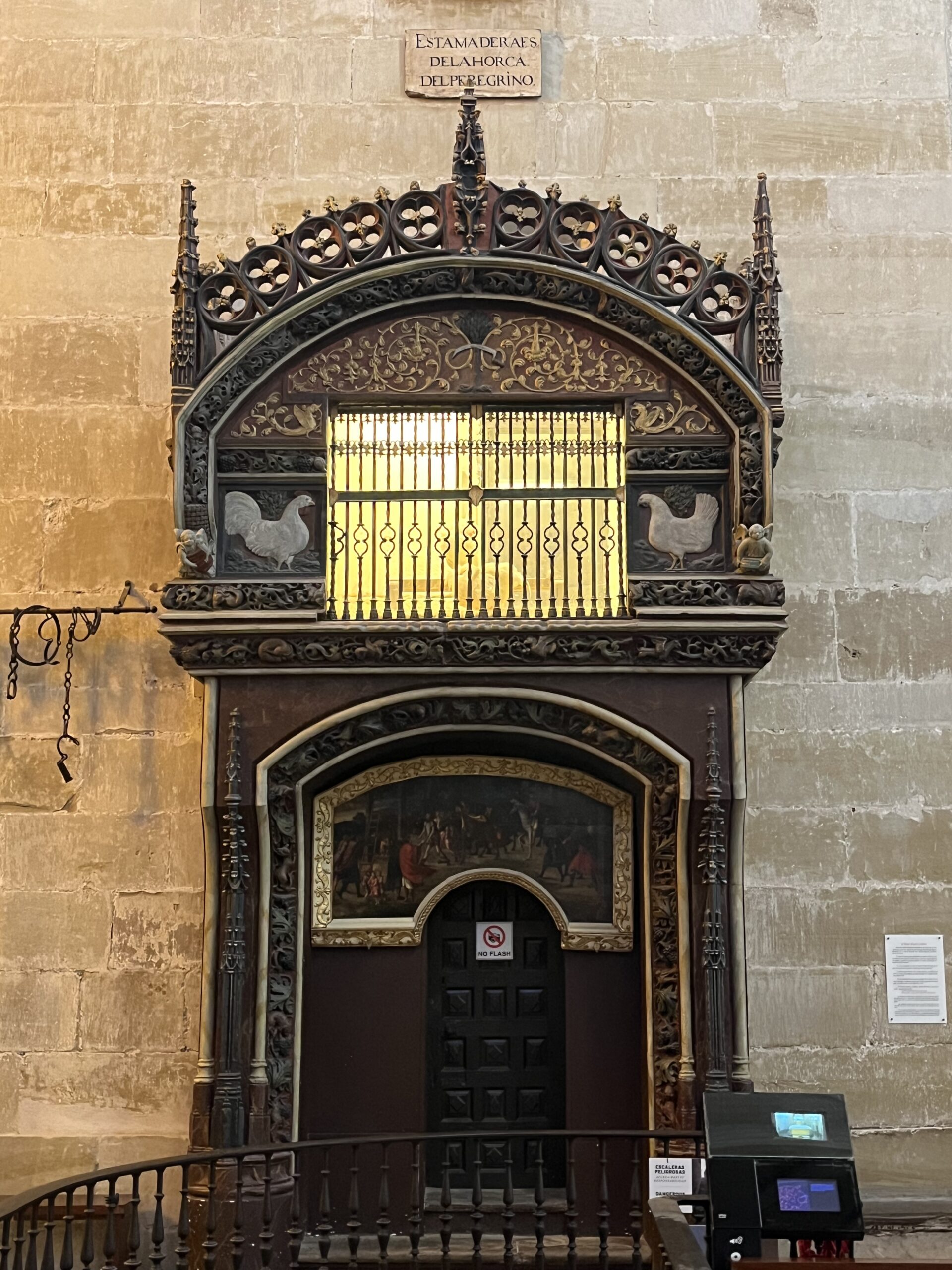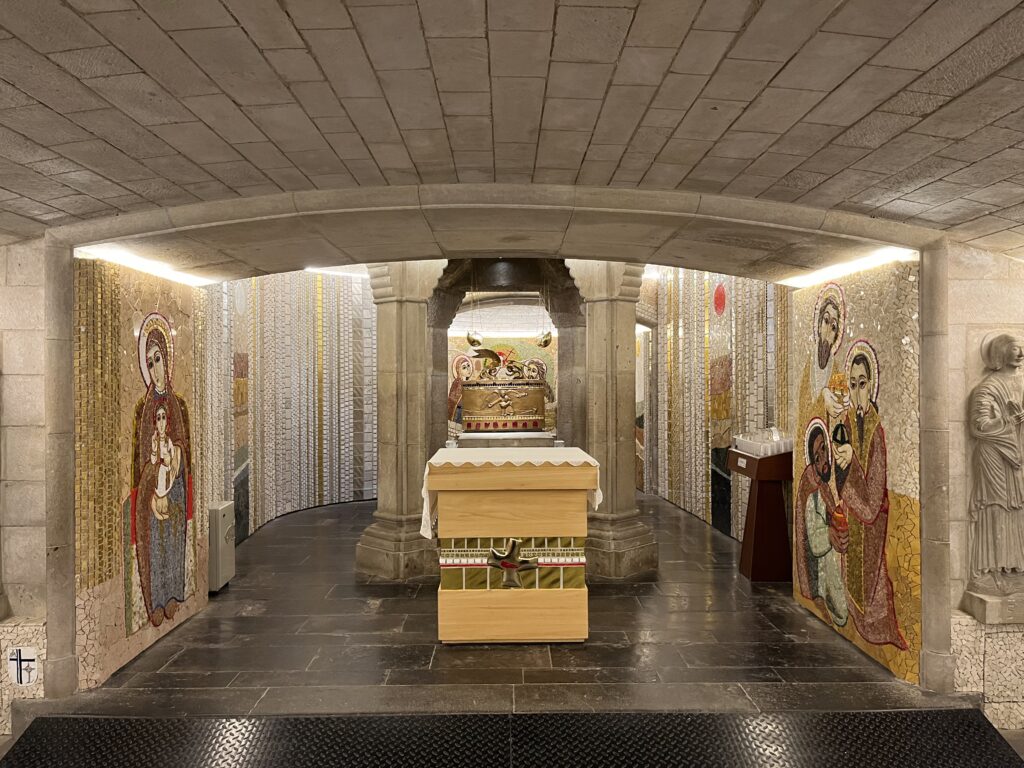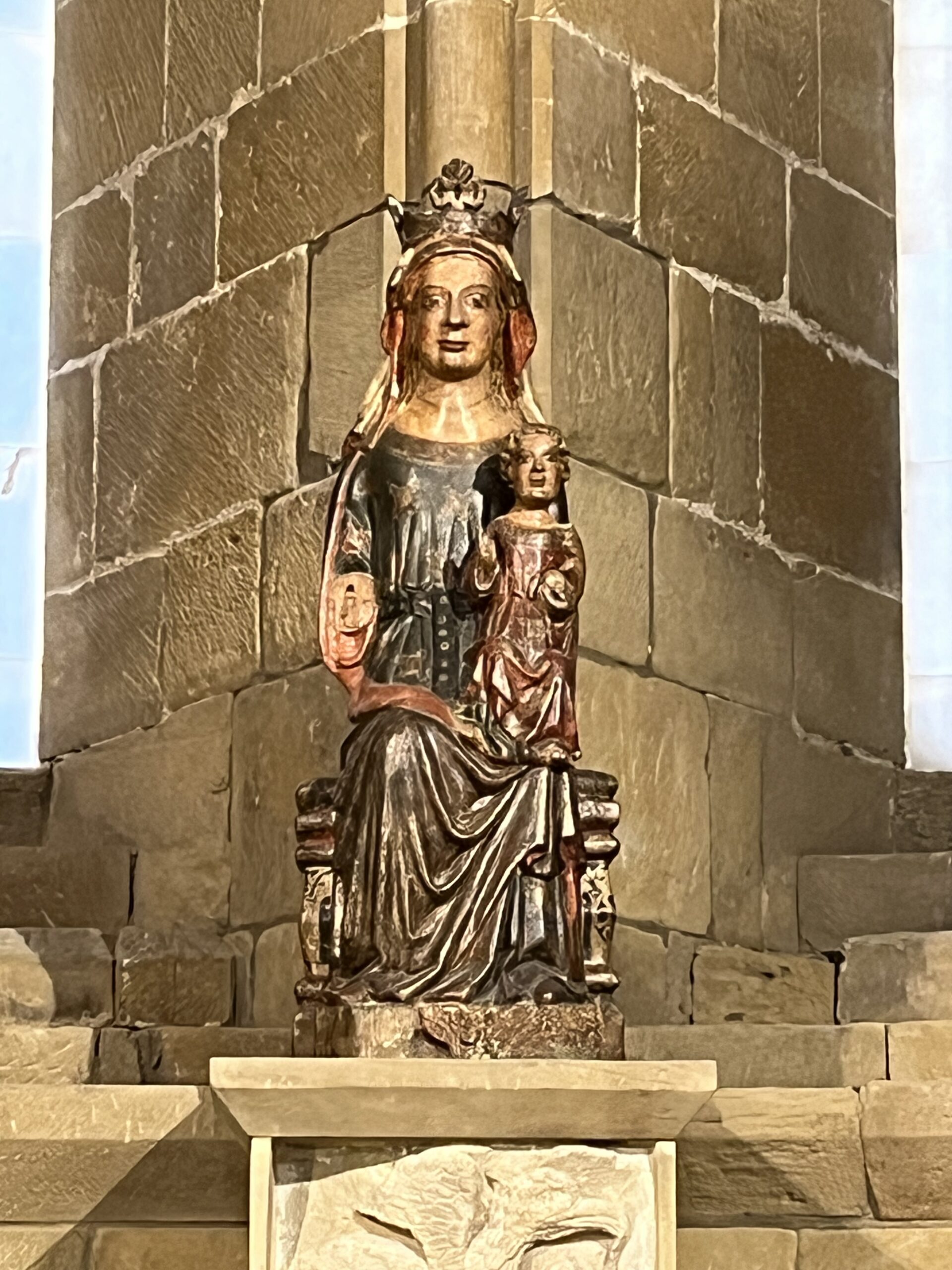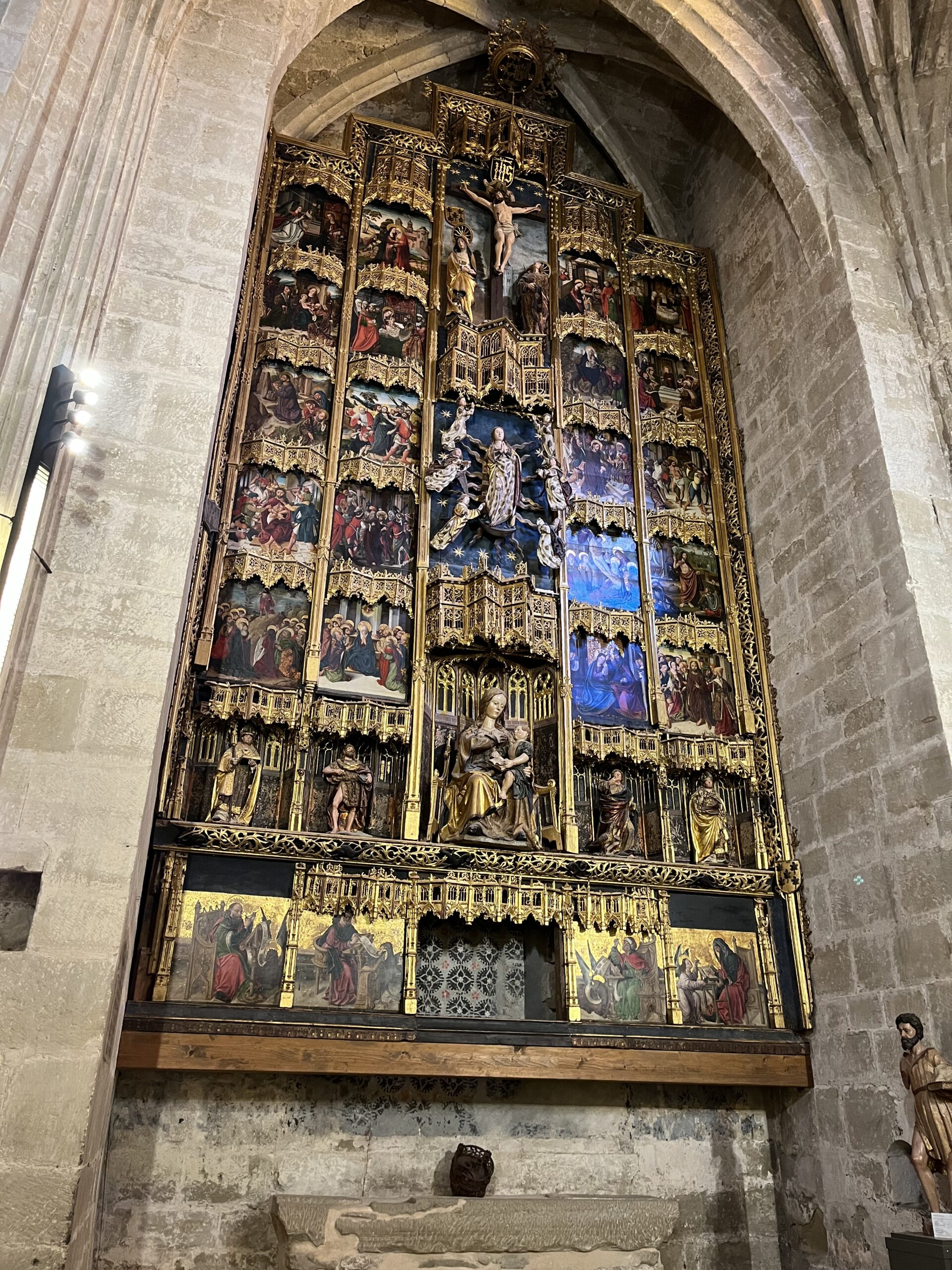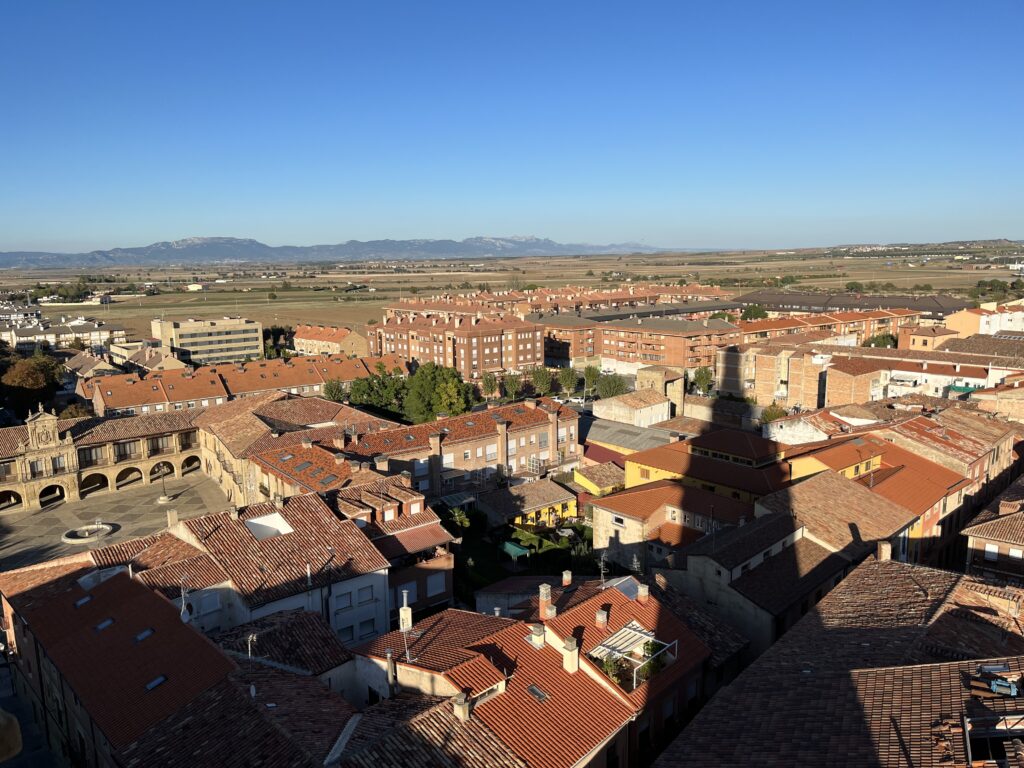Via Podiensis: To Santo Domingo
I learned last night that the storm we walked through in the Pyrenees was one of the worst of the year so far. Winds were clocked at 80 km/h, which is roughly 50 mph.
Up and packed by 6:30, and the question of breakfast was next to tackle. I wandered back to the bridge, trying to make sense out of the markings my host made on a battered tourist map yesterday. In any case I found a little café – no pilgrims but plenty of locals hanging out.
Nobody there wasn’t much of a hurry, and I wasn’t on the road until after seven. this was fine. I had already decided that today was going to be a short day of about 22 km.
Even so, today was another “beat the heat” day. It was still dark when I left, but they were street lights for a bit and the sky was already beginning to lighten.
The Camino started out on the sidewalk, and I was going uphill as the path headed for the bluffs surrounding this side of the town. The Camino turn down a gravel road with a sign indicating 2 1/2 km to the altar they’re not Cara.
The road cut its way through the Bluffs, steep wooded hillsides to each side. The road wasn’t steep by any means, but it was pretty relentless.
Around the corner, and the land opened out. The entire scene was water by the full moon. It was so bright in the darkness, I turned off my flashlight. even when the Camino once more duct in between the hillside – really bluffs at this point – there is no need for the flashlight, so I stirred it.
As I walked through the bluffs, the full moon and the road forward were in perfect alignment, moonlight illuminating the Way. It was a breathtaking and beautiful sight, as though the moon itself were guiding me, and I was walking a path of stars into the moonlight.
Eventually the Camino joined the road, though it was mostly a gravel path next to the actual road. The landscape was nothing but hills and vineyards as far as the eye can see. Walking with a guy from England named Edgar.
We entered the village of Azofra about 8:20 AM in search of second breakfast.
A coffee, two orange juices, and a Napolitano later I was on my way. As I was leaving, many of the pilgrims that I’ve been seeing and walking with over the past week showed up, and it was nice to catch up before heading out.
Minutes later, I was again walking alone through the vineyards of La Rioja. it was about at 9 AM. The morning air was cool, but there was not a cloud in the sky, and I knew the heat of the day would soon arrive.
Shortly there after, I passed a Pillar representing the medieval town limits of Azofra. These sorts of pillars were places where circuit judges would often stop and hold court.
I walk that dirt and gravel road through the rolling vineyards for hours. In a lovely throwback to my time in France, at one point I passed by a vast field of dead sunflowers.
As I walked, I prayed, I sang, and I finished a sonnet that I had started several days ago. also random thoughts occurred to me. Ever since los Arcos every day, sometimes more than once, some well-meaning pilgrim gives me advice about my pack, about my shoes (and how i’m going to get terrible blisters because I am tying them much too loosely), or about how I should pace my walk. I let them.
Also, I miss Orangina. It’s apparently not available in Spain.
At the top of a long hill, just before Ciriñuela, someone set up a food truck at the rest area. I remember getting here ten years ago and collapsing from exhaustion. I certainly wasn’t at that stage this morning, but I did buy a lemon soda and rested a moment. It was about 10:25 AM.
And then into the town of Ciriñuela. This is a modern development anchored by a golf course. When I passed in 2013, and Francine and I went through again in 2016, this place was essentially a ghost town. A developer had come in and built all of these houses and apartments, and the vast majority of them were uninhabited. It was an extremely creepy place.
Somehow, it’s gotten even creepier.
Much of the golf course is overgrown and appears abandoned, though part of it is still in use. The small park that used to greet you on the way into town is now a fenced off thicket.
The buildings are still all closed up, and even the for sale signs look dilapidated. In the entire town, I saw perhaps six inhabited buildings out of hundreds. The only people I saw in the town at all or pilgrims.
Once you’re past the housing developments and into the old village of Cirueña beyond, suddenly there’s life. The houses actually seem lived in, and there are even a couple of albergues and a bar.
The town and roadwalking ended, and the Camino returned to its by now familiar form of a dirt and gravel road into the vineyards and fields behind. It was about 6 km to Santo Domingo de la Calzada, and it was 11 o’clock in the morning.
Santo Domingo is one of those towns that sits in a river valley, so you can’t actually see it until you’re practically there. This can be pretty demoralizing unless you know, particularly when you take into account the unrelenting monotony of the terrain.
At some point the umbrella came out.
Cresting that final hill and seeing the city spread out below never loses its thrill for me, though nothing can compare to that stormy, windy day in 2013 when Patrick, Viola, and I reached that point, semi-delirious, and sure that this was the city paved with queso and chorizo where the fountains ran with Vino Tinto.
The way into the city is a bit arduous, going through some industrial and warehouse areas and over some very tough concrete and asphalt surfaces. But I could always see the spire of the cathedral, like a beacon, urging me forward.
Sometimes we forget that these very physical signs are important guideposts, right until the moment that we need them. Our churches must be beacons of light: beacons of the Gospel radiating the love of Christ. But they also need to be that sacramental sign, a physical beacon representing the spiritual one.
I reached the city proper at about 11:50 AM, and then there was a long stretch of walking on sidewalks to the city center.
I entered the old city center perhaps 15 minutes later, took down the umbrella, and began looking for accommodations.
On the way, I stopped in to pray at the chapel of the 16th century monastery of the Cistercian nuns. A woman there invited me to come in to view the choir, which is arranged around a statue of the corpus of the Lord, prepared for burial. It was a vivid experience, and it stopped me in my tracks for a bit. I also walked around their small but lovely cloister.
By 12:30 I was sitting on my bunk in the municipal albergue.
Then, it was a mad dash buying a pair of pants that fit me, the post office to mail home my other pants, and then a laundromat. Hand washing my fleece did not seem plausible, and it was starting to get to the point I was afraid it was going to walk by itself to Santiago.
I spent a very enjoyable lunch and a couple of beers talking with David from the UK. Wide ranging philosophical discussions of the sort that you only seem to get on the Camino.
Afterwards, I headed for a Cathedral. I was distracted by the 18th century Ermita La Virgen de la Plaza across the plaza from the cathedral. The original Gothic building dates from the 16th century, but it was basically completely rebuilt in the 18th. It’s an amazing, if tiny, little church a visit to which obtains a plenary indulgence. I prayed here and then moved across the plaza.
The weirdest thing about the Cathedral is that the bell tower is actually across a short street from the main building. Very odd.
OK, that’s actually probably the second weirdest thing about the Cathedral. The weirdest thing is the chicken run inside. More about that in a minute.
I have been to the Cathedral twice before, but for one reason or another they were always sort of rushed, and I never had a proper visit until now.
The one place I had visited before was the crypt, wherein Santo Domingo himself is laid to rest. This has been completely redone by a modern artist in the style I can only describe as anime cartoonish. It’s… it’s just awful. I pray that the original mosaics are merely hidden underneath the current ones and that they weren’t destroyed.
It actually made me feel a little ill to be in there.
The same artist has done a number of the stained glass windows in the cathedral, and they are similarly offputting to me.
In many of the side chapels, the original altars have been removed, sometimes leaving the retablos as a sort of decorative museum piece hanging on the walls.
But then, a lot of very questionable decisions about the fabric of this building have been made, one of which is the moving of the grand Baroque retablo from the sanctuary to the north transept and filling the sanctuary with furniture that I can only charitably call 1970s-inspired Danish modern.
In a similar vein, the great Gothic crucifix has been repainted to look like a cartoon caricature from the early 2000s.
I have a devotion to Santo Domingo de la Calzada for a number of reasons, but what they have done to his cathedral is simply scandalous.
Having said that, the cathedral museum is a delight, and the fact that they have not touched the great pseudo-sarcophagus and shrine of the saint that stands above the crypt is nothing short of miraculous.
Speaking of miraculous… About those chickens:
Here is my version of the tale, cobbled together from several different sources.
Sometime in the 14th century, a family of German pilgrims, father, mother, son, were on their way to Santiago. They stopped in the town of Santo Domingo, and a serving girl fell for the boy. He rebuffed her advances and, angered by this, she framed him for theft by sticking some of the silverware in his bag and reporting him to the magistrate.
He was found guilty and hanged.
Sorrowful, his family continued to Santiago to finish their pilgrimage. On the way back, their son appeared to them in a dream saying, “I am not dead. Santo Domingo has held up my body and the hangman’s noose has had no effect on me. Come save me.”
Overjoyed, the parents ran to the magistrate, who was eating his dinner of roast chicken.
They asked that their son be cut down and released, because he was still alive. The magistrate, probably indignant at being interrupted at dinner, shouted back to them in dismissal, “your son is no more alive than these chickens I am eating for dinner.”
Miraculously, The hen and the rooster leapt up from the table now alive (and with their feathers and heads returned) and ran out the door.
The startled magistrate ordered the boy be cut down, and he was indeed alive. The joyful family was reunited.
Since then, confirmed by Papal Bull, a hen and a rooster are kept inside the cathedral at all times.
I prayed Vespers for the feast of Saint Michael the Archangel for the intentions of the Camino with a chicken run to my back and facing the statue and shrine of Santo Domingo de la Calzada. And I prayed for the intercession of this great Saint.
Afterwards, I went to visit the tower. Part has been turned into a museum for the history of clocks, and you can climb up all the way to the top to see the current mechanism and the great stone weights that drive it.
It’s loud. You can hear the mechanisms work like a deep heartbeat throughout the stone of the tower.
At the very top, you stand outside amongst the nine great bells, each named and blessed. And it’s a heck of a view.
Date: 29 September 2023
Place: Santo Domingo de la Calzada
Today started: Nájera
Today’s Photos!
